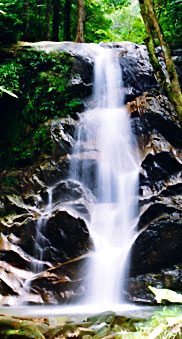Understanding shutter speed – and how it can help your photography
Having read the first part on shutter speed, you're ready to go a little further.
On this page, a little more about what the shutter actually is, and then, keep reading and I'll show you why all this is important!
Great! But what's the "shutter"?
I've mentioned the camera's "shutter" a few times, without actually explaining what it is! It helps to think of this in terms of film cameras.When we used film and not digital sensors to record photos things were a little different. Not much different, just a little!
Film is sensitive to light, so it had to be kept in the dark until you exposed it to take a photo. Once the photo was taken it had to go back into the dark to avoid overexposing it.
So how was this done? Film came in light proof cassettes. You loaded this cassette into your camera. The inside of the camera was also light proof. So once the film was in, it was safely in the dark.
At the front of the camera there was the lens that focussed light onto the film. But stopping the light reaching the film was the shutter blade. This was a thin sheet of metal (or dark cloth in really old cameras), blocking the light.
-
When you pressed the shutter . . . the shutter blade moved out of the way . . . the film was exposed . . . then the shutter blade moved back to re-cover the film. Phew!
A slow shutter speed is considered to be less than 1/30th of a second. Any slower than this (1/15th of a second or less), and it is too difficult to keep the camera still - photos look blurred. If you can keep the camera still enough (by using a tripod, perhaps), then the subject could end up blurred.
A fast shutter speed is considered to be more than 1/500th of a second. Because the film is exposed for such a brief period, movement is frozen. These are the speeds sports photographers use to freeze athletes in motion.
Film? And you thought this was a digital photography site! Yep, it is. All you have to think about when it comes to digital photography is that the film has now been replaced by an electronic image sensor.
So instead of the film being exposed, in digital photography the image sensor is exposed. The effect is exactly the same as if you were using film.
Fast shutter speed, slow shutter speed – what use is knowing that?
Once you know that a slow shutter speed will result in blur, and a fast shutter speed will freeze action, you can put it to creative use.For example, if you are taking photos of children on school sports day, you might want to freeze the moment when they cross the finish line. You now know that you will need a fast shutter speed to do this!
 If you are taking photos where you want to show movement, you could use a slow shutter speed.
If you are taking photos where you want to show movement, you could use a slow shutter speed.
Flowing water is a common one - because of the slow shutter speed the water will appear blurred (because it moved when the shutter was open), but anything that didn't move would be in focus.
Have a look at the photo to the left here. It demonstrates this use of slow shutter speed.
I took this photo in Malaysia. It's one of the seven waterfalls that make up the Kanching waterfalls.
I deliberately used a slow shutter speed to show the movement in the water, but, because nothing else in the photo moved, the rest of the photo is in focus.
Further reading . . .
Now you have an understanding of what we mean by fast shutter speed and slow shutter speed, you might find the following pages worth a read:- Understanding exposure – shutter speed/aperture
- Understanding aperture
- Using aperture to control depth of field
- Using shutter speed creatively
- Stay Focussed - free monthly newsletter
